La presenza e l’azione dell’essere umano tendono spesso a distogliere l’attenzione da tutto ciò che invece lo circonda, dall’ambiente che di fatto lo accoglie e della natura che continua il suo ciclo vitale con o senza la sua presenza; tuttavia la maggior parte degli artisti contemporanei, continuando il percorso intrapreso da alcuni movimenti del secolo scorso, dedicano la loro produzione a esplorare l’interiorità, le profondità e le sensazioni che appartengono alla sfera più intima dell’individuo, comprese le angosce e le paure. Esiste però un’altra categoria di creativi che sentono il bisogno di osservare ciò che li circonda, di evidenziarne la semplice bellezza e spontaneità e infondere nelle tele le sensazioni che ricevono da quell’osservazione. Il protagonista di oggi appartiene a quest’ultima categoria di artisti.
Verso la fine degli anni Venti del Novecento, dunque dopo le sperimentazioni artistiche degli anni precedenti in cui il distacco dalla realtà osservata costituì la base di molti movimenti pittorici e scultorei che si imponevano non solo di sottolineare la supremazia del gesto plastico rispetto alla figurazione ma anche di superare la perdita di certezze e il ricordo delle atrocità a cui gli artisti, come i popoli, avevano assistito durante la Prima guerra mondiale, volendosi pertanto astrarre da un quotidiano che non poteva più costituire una fonte di ispirazione, si ebbe una vera e propria inversione di tendenza creativa. Recuperata una maggiore stabilità dopo la fine del conflitto e terminata quella fase esplorativa dell’Astrattismo, alcuni movimenti come il Surrealismo si soffermarono sulle angosce e gli incubi dell’inconscio che appartenevano all’uomo di quel periodo storico; altri, come l’Espressionismo, si legarono fortemente all’irrazionalità delle emozioni e del sentire mettendo in secondo piano persino l’armonia esecutiva pur di assecondare l’atto creativo a quel mondo emozionale che doveva emergere; e infine alcuni vollero invece ritornare all’ordine, alla contemplazione placida di panorami, di scorci di città o di campagna, mantenendo alcuni tratti del coevo Espressionismo, almeno dal punto di vista puramente esecutivo dell’opera, ma al tempo stesso perdendo le caratteristiche più irruente ed eccessive, suggerendo la necessità di un ritorno a un approccio in cui mescolare l’innovazione sperimentata con un orientamento più classico. In Italia vi furono due scuole che assunsero queste linee guida come base creativa, a Milano il Gruppo Novecento, di cui fu fondatore e massimo esponente Mario Sironi, e a Roma la Scuola di via Cavour, che in qualche modo volle costituire una risposta all’ordine degli artisti milanesi mantenendo un approccio formale molto espressionista. Eppure tra gli aderenti a questa corrente, vi furono alcuni esponenti che invece si avvicinarono alla pacatezza e alla serenità del Gruppo Novecento, come Mario Mafai, con le sue vedute di Roma, i suoi ponti e i suoi tetti in cui emergeva un lieve legame con il Cubismo, e qualche anno dopo Paolo Salvati che invece volle legarsi all’Espressionismo soprattutto per la scelta cromatica necessariamente affine alla sua sensibilità e alle sue emozioni, pur infondendo nelle sue tele un equilibrio contemplativo in cui il silenzio è elemento fondante e punto di osservazione imprescindibile. L’artista romano Mario Marzi assorbe da Salvati la tendenza a lasciare che i suoi soggetti, campagne, animali del bosco o della foresta, scorci marini, divengano protagonisti assoluti di un fotogramma, un fermo immagine che sembra coglierli all’improvviso catturando la loro attenzione ma poi di fatto costituendo un elemento trascurabile, una distrazione minuscola nell’ordine delle cose.
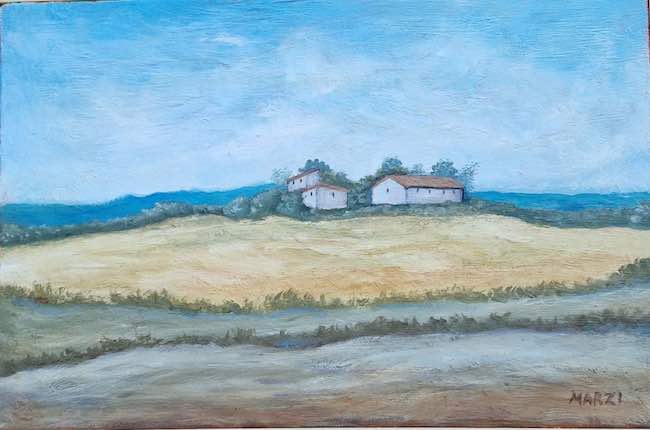

Ciò che sorprende delle tele di questo artista non è solo il tratto espressionista e tuttavia incredibilmente realista dal punto di vista cromatico bensì l’immobilità che emerge, quasi come se davanti al suo sguardo pittorico tutto il mondo si fermasse e si mettesse in posa per lasciare un ricordo di sé; il tratto è semplice, immediato, proprio perché è attraverso la semplicità, sembra suggerire Marzi, che è possibile assorbire la vera essenza di ciò che si osserva, quell’anima nascosta che si svela solo davanti a un occhio sensibile e in grado di coglierne le più profonde sfumature. Una delle principali caratteristiche dei dipinti di Mario Marzi è la luminosità, quella luce soffusa che in alcuni casi intensifica i colori che fanno parte della composizione, in altri invece sembra rarefare le ambientazioni descritte, come se fosse proprio in virtù delle tonalità tenui che potesse evidenziarsi ed emergere con maggiore forza la solennità di quanto circonda l’individuo troppo spesso incapace di coglierne la bellezza intrinseca, la magia che si diffonde nell’istante esatto in cui lo sguardo si posa su un paesaggio o su un animale selvaggio.
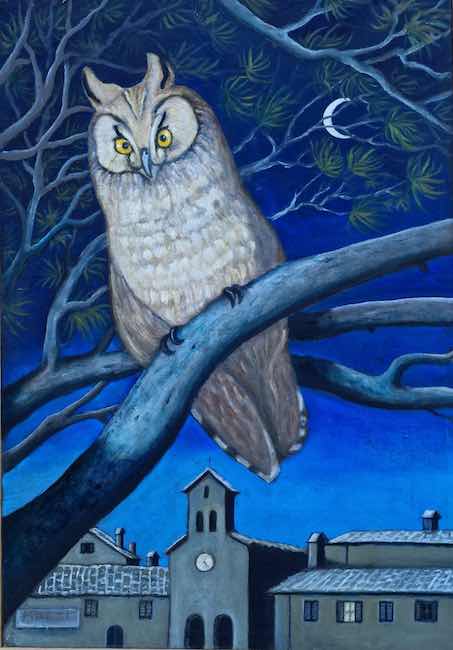
L’assenza dell’uomo appare come un invito a restare in silenzio davanti a tanta sensibile armonia, e al tempo stesso amplifica la sensazione che le opere siano sospese in un non-tempo, un istante in cui il precedente è già accaduto e il successivo deve ancora verificarsi, ed è proprio lì che si insinua l’artista, nell’immobilità silenziosa di un irripetibile attimo che l’individuo può solo ammirare, ponendosi solo di fronte a ciò che gli si apre davanti ascoltando i battiti interiori sollecitati a vibrare.
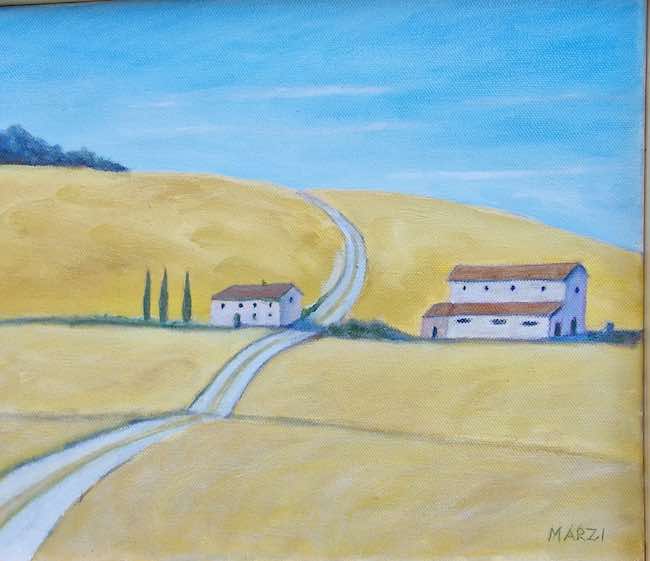
La tela Paesaggio toscano evoca la serenità, il canto delle cicale, l’odore di grano che avvolge quei luoghi incantati e che Mario Marzi descrive con tocco morbido, come se quelle colline appartenessero al suo scrigno della memoria, come se si legassero a un vissuto piacevole in cui l’equilibrio e la serenità sono stati i punti focali; la strada al centro del dipinto va però oltre l’immagine, diventa metafora del cammino della vita, quel percorso che ciascuno deve intraprendere per scoprire se stesso, affrontando le salite e le discese che condurranno verso il domani, da scrivere passo dopo passo. Il suggerimento nascosto è quello di affrontare la vita con fiducia e tranquillità perché in fondo tutto ciò che può accadere avrà un senso che verrà compreso subito dopo aver oltrepassato la successiva collina, per quanto alta possa sembrare.
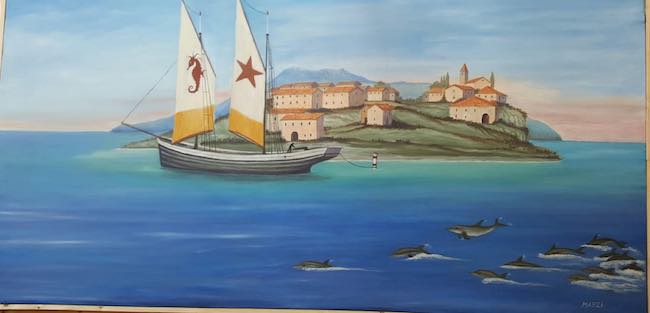
Il desiderio di equilibrio e di tranquillità è un punto focale dell’approccio alla vita di Mario Marzi che non può fare a meno di fuoriuscire in tutta la sua produzione artistica e che spesso emerge persino dai titoli, come in L’isola della serenità appartenente alla serie pittorica delle marine; qui la luce è più intensa, i colori sono più saturi forse perché il panorama descritto appartiene al mondo del sogno diventando un luogo ideale all’interno del quale perdersi. Le colline si trasformano in un’isola circondata dal mare azzurro dove è attraccata un’imbarcazione che sembra non aver bisogno di prendere il largo perché in fondo ha già tutto ciò di cui ha bisogno nel punto esatto dove si trova. Quest’opera di impronta più simbolista, sembra ancora una volta essere un’allegoria dell’uomo il quale fa fatica ad apprezzare ciò che ha, andando a cercare all’esterno tutto ciò che già appartiene alla sua vita, sebbene in forma diversa rispetto a quella attesa; la capacità di Marzi di evidenziare la piacevolezza della serenità persino quando irreale – il paesaggio collinare non può digradare fino al mare -, induce l’osservatore a riflettere su se stesso e su quanto sia molto più semplice e appagante soffermarsi a dare maggiore valore a ciò che ha.
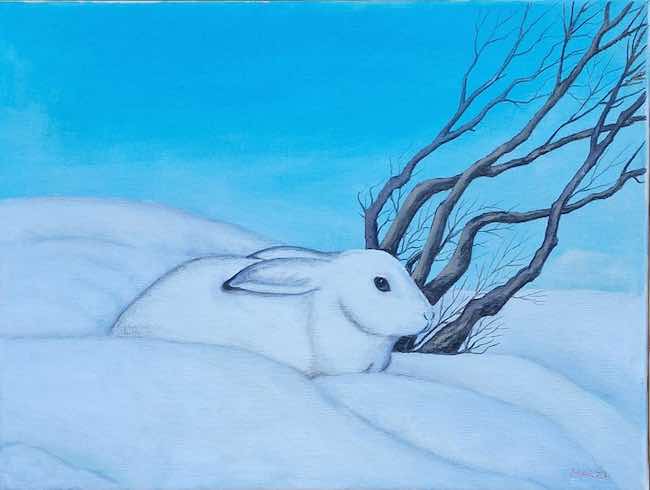
Nei dipinti dedicati agli animali l’artista svela ancor di più la sua ammirazione per una fauna distante da quella domestica a cui l’uomo è abituato, e anche la sua capacità di osservazione di atteggiamenti naturali eppure affascinanti nella loro inconsapevolezza di costituire la base dell’esistenza; lo sguardo di Marzi si posa, ancora una volta, sull’istante in cui tutto è fermo, in cui la Lepre artica è poggiata sulla neve, candida quanto il suo manto, poco prima che decida di saltare e allontanarsi, magari non appena percepirà un rumore o solo perché sceglierà di spostarsi.
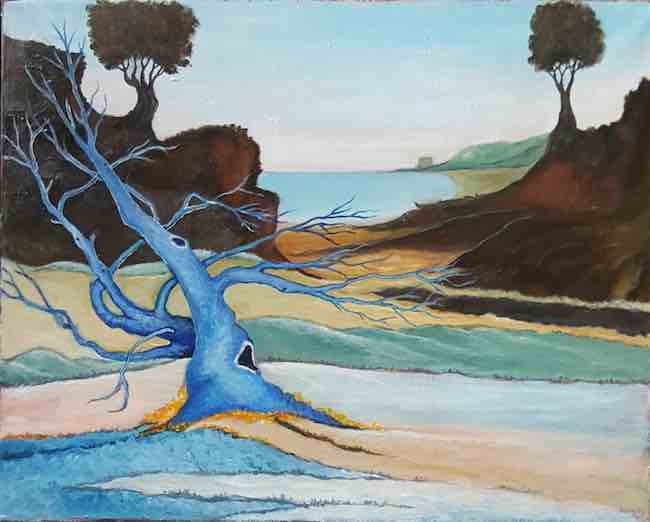
L’opera Albero blu portatore di pace è liberamente ispirata al celebre dipinto Albero blu di Paolo Salvati, artista storicizzato che ha costituito una voce solista nel panorama artistico romano, e riproposta da Mario Marzi attraverso il suo stile, con il suo tendere verso la serenità e la calma che contraddistingue i suoi dipinti; il paesaggio alle spalle dell’albero in primo piano, con i rami spogli e quasi piegato dagli eventi, è rassicurante perché le acque dell’insenatura sono piatte, cristalline e invitano l’osservatore a lasciarsi andare a quell’ideale di tranquillità. Mario Marzi è membro dell’Associazione Cento Pittori di Via Margutta, con cui espone regolarmente, ha lavorato per committenti privati ed enti religiosi e dal 2022 è citato sul Getty Vocabulary di Los Angeles, e sull’Enciclopedia d’Arte Italiana.
MARIO MARZI-CONTATTI
Email: mariomarzi58@gmail.com
Sito web: https://www.centopittoriviamargutta.it/mario-marzi/
Facebook: https://www.facebook.com/profile.php?id=100077470470575
The enchantment of silence in Mario Marzi’s motionless landscapes, when man leaves room for nature
The presence and action of human beings often tend to distract attention from everything that surrounds them, from the environment that actually welcomes them, and from nature, which continues its life cycle with or without their presence. However, most contemporary artists, continuing the path taken by certain movements of the last century, devote their production to exploring the interiority, depths and sensations that belong to the most intimate sphere of the individual, including anxieties and fears. However, there is another category of creative artists who feel the need to observe their surroundings, to highlight their simple beauty and spontaneity and infuse their canvases with the feelings they receive from that observation. Today’s protagonist belongs to the latter category of artists.
Towards the end of the 1920s, thus after the artistic experiments of the previous years in which detachment from observed reality formed the basis of many pictorial and sculptural movements that were not only intended to emphasise the supremacy of plastic gesture over figuration, but also to overcome the loss of certainties and the memory of the atrocities that artists, like people, had witnessed during the First World War, thus wanting to abstract themselves from an everyday life that could no longer be a source of inspiration, there was a real reversal of the creative trend. Having recovered greater stability after the end of the conflict and having completed that exploratory phase of Abstractionism, some movements such as Surrealism dwelt on the anxieties and nightmares of the unconscious that belonged to the man of that historical period; others, such as Expressionism, bound themselves strongly to the irrationality of emotions and feeling, putting even executive harmony in the background in order to indulge the creative act in that emotional world that had to emerge; and lastly, some wanted instead to return to order, to the placid contemplation of panoramas, of views of cities or the countryside, maintaining some traits of the coeval Expressionism, at least from the purely executive point of view of the artwork, but at the same time losing the more impetuous and excessive characteristics, suggesting the need for a return to an approach in which experimented innovation was mixed with a more classical orientation. In Italy, there were two schools that took these guidelines as their creative basis, in Milan the Novecento Group, of which Mario Sironi was the founder and greatest exponent, and in Rome the Scuola di via Cavour, which in some ways wanted to be a response to the order of the Milanese artists while maintaining a very expressionist formal approach. Yet among the adherents of this current, there were some exponents who instead approached the calmness and serenity of the Novecento Group, such as Mario Mafai, with his views of Rome, its bridges and rooftops in which a slight link with Cubism emerged, and a few years later Paolo Salvati who, instead, wanted to link himself to Expressionism mainly due to the choice of colours necessarily akin to his sensitivity and emotions, while infusing his canvases with a contemplative balance in which silence is a founding element and an essential point of observation.
The Roman artist Mario Marzi absorbs from Salvati the tendency to let his subjects – countryside, woodland or forest animals, marine views – become the absolute protagonists of a photogram, a still image that seems to catch them suddenly, capturing their attention but then in fact constituting a negligible element, a tiny distraction in the order of things. What is surprising about this artist’s canvases is not only the expressionist and yet incredibly realistic stroke in terms of colour, but rather the stillness that emerges, almost as if in front of his pictorial gaze the whole world stopped and posed to leave a memory of itself; the stroke is simple, immediate, precisely because it is through simplicity, Marzi seems to suggest, that it is possible to absorb the true essence of what is being observed, that hidden soul that is only revealed before a sensitive eye capable of grasping its deepest nuances. One of the main characteristics of Mario Marzi’s paintings is their luminosity, that suffused light that in some cases intensifies the colours which are part of the composition, while in others it seems to rarefy the settings described, as if it were precisely by virtue of the soft tones that the solemnity of what surrounds the individual, too often unable to grasp its intrinsic beauty, the magic that spreads in the exact instant when one’s gaze rests on a landscape or a wild animal.
The absence of man appears as an invitation to remain silent in front of such sensitive harmony, and at the same time amplifies the sensation that the artworks are suspended in a non-time, an instant in which the previous has already happened and the next has yet to occur, and it is precisely there that the artist insinuates himself, in the silent immobility of a unrepeatable moment that the individual can only admire, standing alone in front of what opens up before him, listening to the inner beats urged to vibrate. The canvas Tuscan Landscape evokes serenity, the song of cicadas, the smell of wheat that envelops those enchanted places and which Mario Marzi describes with a soft touch, as if those hills belonged to his treasure chest of memory, as if they were linked to a pleasant experience in which balance and serenity were the focal points; the road at the centre of the painting, however, goes beyond the image, it becomes a metaphor for the path of life, that path that each person must take to discover himself, facing the ups and downs that will lead towards tomorrow, to be written step by step. The hidden suggestion is to face life with confidence and tranquillity because after all, everything that may happen will have a meaning that will be understood soon after crossing the next hill, however high it may seem.
The desire for balance and tranquillity is a focal point of Mario Marzi’s approach to life that cannot fail to emerge in all his artistic production and often even emerges from the titles, as in The Island of Serenity belonging to the pictorial series of seascapes; here the light is more intense, the colours are more saturated, perhaps because the landscape described belongs to the world of dreams, becoming an ideal place in which to lose oneself. The hills are transformed into an island surrounded by the blue sea where a boat is moored that seems not to need to put out to sea because it already has everything it needs in the exact spot where it is. This painting, with its more symbolist imprint, once again seems to be an allegory of man who finds it hard to appreciate what he has, going out to seek everything outside that already belongs to his life, albeit in a different form than expected. Marzi’s ability to emphasise the pleasantness of serenity even when unreal – the hilly landscape cannot slope down to the sea -, induces the observer to reflect on himself and on how much simpler and more satisfying it is to pause and give greater value to what he has. In the paintings dedicated to animals, the artist reveals even more of his admiration for a fauna that is far removed from the domestic one to which man is accustomed, and also his ability to observe attitudes that are natural yet fascinating in their unawareness that they form the basis of existence; Marzi’s gaze rests, once again, on the instant in which everything is still, in which the Arctic Hare is resting on the snow, as white as its coat, just before it decides to jump and move away, perhaps as soon as it perceives a noise or just because it chooses to move. The painting Blue Tree, bearer of peace is freely inspired by the famous painting Blue Tree by Paolo Salvati, an historic artist who has constituted a solo voice in the Roman art scene, and re-proposed by Mario Marzi through his style, with its tendency towards serenity and calmness that characterises his paintings; the landscape behind the tree in the foreground, with its bare branches and almost bent by events, is reassuring because the waters of the inlet are flat, crystal clear and invite the observer to indulge in that ideal of tranquillity. Mario Marzi is a member of the Associazione Cento Pittori di Via Margutta, with which he exhibits regularly, has worked for private clients and religious bodies, and since 2022 has been mentioned in the Getty Vocabulary in Los Angeles, and in the Enciclopedia d’Arte Italiana.














